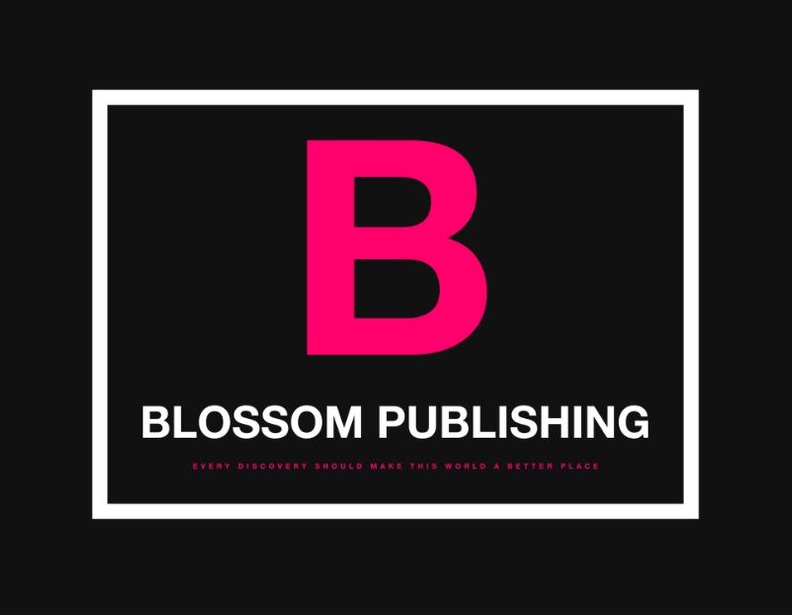Scientific publications WEB OF SCIENCE and SCOPUS start with
Blossom PublishingLight tomorrow with today
About the Company
The successful publication and subsequent indexing of an article depend on the choice of the executor, who takes on the responsibility of promoting the articles. The founder of Blossom Publishing serves as the company's chief editor and has over 10 years of experience in writing, editing, and publishing literature of various complexities in international journals. Additionally, the founder has experience in creating scientific frameworks that support scientists in their research endeavors.
Blossom Publishing is a hub where researchers, authors, and journal editors from Europe, Asia, the USA, and East Asia have come together. Our international team develops effective journal publishing algorithms based on Web of Science, Scopus, and other global platforms. We assist authors at all publication stages and offer around-the-clock support.
At Blossom Publishing, clients collaborate directly with the Editor-in-Chief of the publishing house. This mode of interaction proves highly effective, offering numerous benefits such as swift responses, precise execution, comprehensive awareness of article-related issues, detailed order information, understanding of deadlines, interacting in a common language, and efficiency in achieving desired outcomes. Additionally, engaging with the Editor-in-Chief ensures a positive publication experience and a commitment to delivering superior quality.
We prioritize our reputation at Blossom Publishing and uphold a commitment to providing diligent services to facilitate publication in esteemed databases such as SCOPUS, WEB OF SCIENCE, EBSCO, PubMed, RePec, Crossref, Cabell's Directory, DOAJ, Google Scholar, Index Copernicus, SOBIAD, Academia.edu, and Mendeley. Journals seek to partner with us due to our dedication to ensuring high-quality output.
The publication timeline at Blossom Publishing is contingent upon: 1) author preferences; 2) research subject matter; 3) the readiness of the material for publication; and 4) the journal's rating requirements. We have tailored offers available that can be executed within specified timeframes: ranging from 4 to 7 days, 1 to 2 months, and 3 to 6 months. We adhere strictly to deadlines, earning the trust and appreciation of our clients.
Each project receives individualized attention and is regarded as a top priority. Please feel free to submit your materials, inquiries, and suggestions to our email address at blossompublishing.media@gmail.com or contact us at +380505748774. You can also leave a request below, and a Blossom Publishing editor will promptly reach out to assist you.
Publishing and Editorial Services
"Every discovery should make this world a better place
Blossom Publishing guarantees the publication of scientific materials in reputable journals. Our mission is to facilitate the dissemination of knowledge, support research and scientific discoveries, and provide access to valuable information for the academic community and the public. We are committed to enhancing the level of scientific research, publishing high-quality materials, and supporting scientific innovations to advance science and education. Our team is always ready to assist you in implementing ideas and achieving scientific goals.
The publishing house offers:

Professional Writing Services

Plagiarism Check

Revision
We will study and carefully analyze the initial text to ensure the correct reproduction of content and context. If a revision of the article is needed, we will assist with it. Our publishing house is ready to support the scientific idea, deepen the research, and increase its scientific value by finding the right approach for each case. We will enhance the logical structure of the text, including the correct sequence of thoughts and arguments.

Professional Translation Services

Proofreading and Editing

References

Citation

International Collaboration

Formatting Standards

Indexing

Publishing

Pricing Policy of Blossom Publishing
We offer both comprehensive professional solutions and individual editing and publishing services. Our advantages include high-quality editing, accelerated publication timelines, and a personalized approach to each author.
Installments Option: The initial payment is 50% upon signing the agreement, and the remaining 50% is due after the official confirmation of the article's acceptance for publication.
OFFER DETAILS
SCOPUS / WEB OF SCIENCE
“UNIVERSAL” PROFESSIONAL SOLUTIONS COMPLEX
SERVICE PACKAGE
1. Writing an article that includes an analysis of previous research and publications on the given topic to summarize the available information; description of the methods, procedures, and approaches used in the research; collection, analysis, and interpretation of the results obtained to confirm the hypothesis and conclusions of the study; a well-reasoned presentation of the research in the form of a scientific article in professional English to ensure the proper level of competence and adherence to scientific publication standards.
2. Editing the text structure: improving the logical structure of the text, including the correct sequence of thoughts and arguments.
3. Search and correction of errors in citation and formatting: ensuring the correct use of quotes, references, and formatting according to the requirements of the specific citation style (e.g., APA, MLA).
4. Revision: making necessary corrections, clarifications, or enhancements to the text to ensure the quality and clarity of the research.
5. Proofreading: final stage of checking the text for any errors before submission.
6. Selection of a journal based on the following criteria: thematic relevance, ranking and impact factor, author requirements, publication timeline, reviews, and reputation.
7. Adherence to the ethical code: ensuring compliance with ethical norms and rules of publication in scientific journals.
8. Ensuring full support in the process of reviewing, publishing, and indexing the article, including negotiations and correspondence with journal editors and reviewers to guarantee the quality and conformity of the scientific article to publication standards; addressing reviewers' comments; revising article texts according to publication requirements; providing additional detailed information on the scientific experiment or research if required to confirm the article's credibility and value; working with images, literature sources, citations; preparing and submitting necessary documentation to the journal; implementing the publication of the article; ensuring article indexing; rectifying errors in the database (if any) after indexing; providing informational support throughout the process.
9. Covering fees related to the publication process, including such publishing services as publishing activities and projects, expert reviewing, publication expenses, editorial charges, open access to research, marketing and communication, general discounts and waivers, surpluses.
SCOPUS / WEB OF SCIENCE
“BALANCED” PROFESSIONAL SOLUTIONS COMPLEX
SERVICE PACKAGE
1. Materials analysis: studying and carefully analyzing the original text to ensure the correct reproduction of content and context.
2. Text translation: professional translation of materials into English, considering the nuances of terminology and appropriate scientific style.
3. Text structure editing: improving the logical structure of the text, including the correct sequence of thoughts and arguments.
4. Searching for and correcting errors in citation and formatting: ensuring the correct use of quotes, references, and formatting according to the requirements of the specific citation style (e.g., APA, MLA).
5. Revision: making necessary corrections, clarifications, or enhancements to the translated text to ensure the quality and clarity of the research.
6. Proofreading: the final stage of checking the text for any errors before submission.
7. Choosing a journal based on the following criteria: thematic relevance, rating and impact factor, author requirements, publication timeline, reviews, and reputation.
8. Adherence to the ethical code: ensuring compliance with ethical norms and rules of publication in scientific journals.
9. Ensuring full support in the process of reviewing, publishing, and indexing the article, including negotiations and correspondence with journal editors and reviewers to guarantee the quality and conformity of the scientific article to publication standards; addressing reviewers' comments; revising article texts according to publication requirements; providing additional detailed information on the scientific experiment or research if required to confirm the article's credibility and value; working with images, literature sources, citations; preparing and submitting necessary documentation to the journal; implementing the publication of the article; ensuring article indexing; rectifying errors in the database (if any) after indexing; providing informational support throughout the process.
10. Covering fees related to the publication process, including such publishing services as publishing activities and projects, expert reviewing, publication expenses, editorial charges, open access to research, marketing and communication, general discounts and waivers, surpluses.
SCOPUS / WEB OF SCIENCE
"PRIMARY" PROFESSIONAL SOLUTIONS COMPLEX
SERVICE PACKAGE
1. Materials analysis: studying and carefully analyzing the original text to ensure the correct reproduction of content and context.
2. Grammar and spelling analysis: checking and correcting any grammatical errors as well as spelling inaccuracies in the text.
3. Stylistic editing: improving the writing style to adhere to academic standards or specific writing style requirements.
4. Syntax analysis: checking and correcting syntactic constructions in the text to ensure its logical flow and clarity.
5. Indentations and formatting: checking and correcting paragraph indentation, paragraph alignment, and overall text formatting.
6. Text structure editing: improving the logical structure of the text, including the correct sequence of thoughts and arguments.
7. Searching for and correcting errors in citation and formatting: ensuring the proper use of quotes, references, and formatting according to the requirements of the specific citation style (e.g., APA, MLA).
8. Proofreading: the final stage of checking the text for any errors before submission.
9. Selecting a journal based on the following criteria: thematic relevance, rating, impact factor, author requirements, publication timeline, reviews, and reputation.
10. Adherence to the ethical code: ensuring compliance with ethical norms and rules of publication in scientific journals.
11. Providing full support in the process of peer-review, publication, and indexing of the article, including negotiations and correspondence with journal editors and reviewers to guarantee the quality and conformity of the scientific article to publication standards; addressing reviewers' comments; revising article texts according to publication requirements; providing additional detailed information on the scientific experiment or research if required to confirm the article's credibility and value; working with images, literature sources, citations; preparing and submitting necessary documentation to the journal; implementing the publication of the article; ensuring article indexing; correcting errors in the database (if any) after indexing; providing informational support throughout the process.
12. Coverage of fees related to the publication process, including such service functions of publications as publishing activities and projects, expert reviewing, publication costs, editorial fees, open access to research, marketing, and communication, general discounts and waivers, surplus.
Author Guidelines from Blossom Publishing
1. The article's length is 3000 to 8000 words (depending on the journal's specifics). The optimal length is 4000-6000 words, including the references.
2. Originality of the text: 95% and higher.
3. For text typing, formulas, and tables, you should use Microsoft Word for Windows. Text Options: all margins – 2 cm; font – Times New Roman; font size – 12; line spacing – 1; alignment – in width; paragraph indent – 1 cm; sheet orientation is portrait.
4. All visual objects should be provided in .jpeg or .png format. It is necessary to assign a serial number to the image and give a name (for example, Figure 1. Name of the figure). Any drawings (including graphs and diagrams) should be equally informative in black and white, and color resolution. Scanned objects are not allowed. Images must be clear, and the inscriptions are visible.
5. Tables are placed in the article. It is necessary to give the table number and its name (for example, Table 1. Name of the table). Scanned objects are not allowed. Each table should have a description in the text of the article.
6. Formatting the article's metadata: The article's full title. A shortened version of the title of the article (Running title). Name and Last name of the author(s) of the article (patronymic is optional). Academic title, academic degree, position. Place of employment: department, faculty, name of the University. City, country. Work address, zip code, work phone, email address, ORCID.
7. The article must have the text's structure, logic, and conceptual generality. In addition, headers must be signed and contain the following information:

The optimal volume is 150-250 words. In case of non-compliance with the requirements, the publisher reserves the right to partially change, reduce or increase the volume of the instructions. The abstract should include:
- Expediency of the study;
- A brief and concise description of the relevance of the investigated problem;
- The purpose of the article;
- Leading method for researching the problem (if the article is empirical)/Leading approach to researching the problem (if the article is theoretical);
- Research results (what is discovered, substantiated, revealed, developed, proved in the article);
- Practical and theoretical significance of the obtained results (increase in efficiency/improvement, etc.).

Quantity: 5-9 words of the article's essence, which can be used to compile a citation index.
Keywords or key phrases are separated from each other by commas/semicolons, depending on the journal's instructions.

A short introduction, which describes the problematic of the researched issue and notes the importance of this issue. The input should contain:
- The wording of the text of this section is from general to partial;
- Formulation of research hypothesis;
- Formulation of the purpose and tasks of this research.

In the literature review, you must cite only known sources, including at least 15 English-language articles. Foreign articles are indicated with a DOI number, books and others with a link to the access mode. The main provisions of the section:
- Introduction. Define the topic and give reasons for choosing it. It is also possible to note in general trends, problems and topics that arise);
- Main part. Consider your sources. You can build your comment (consideration of the issue) in chronological, thematic or methodological order;
- Conclusion. Summarize key publications, assessing the current state of play and pointing out methodological weaknesses, research gaps, controversies, and directions for further research.
What is prohibited in this section:
- Just write a list of sources;
- Cite authors without citing them.

A description of the methods used in the data collection of the article. The section should contain:
- Designation of the experimental base and research sample;
- A detailed but, at the same time, concise description of each method and technique separately (in individual paragraphs). Sometimes it is necessary to describe why a particular method was chosen.
- A brief description of the experiment/research scheme.

Results should state the main conclusions and provide detailed evidence (such as quotations or figures) to support the theory. The section should contain the following:
- Experimental data;
- All figures and tables must be accompanied by explanations, in which the reference to this or that table or figure is marked;
- Formulation of all key statistical data (number of samples, dispersion index, levels, etc.).

Results are discussed within the framework of the dominant concept and hypothesis being tested. The section should contain:
- A brief overview of the study;
- A brief description of the most significant results that were found in the "Results" section and their comparison with other studies devoted to the sample topic, the selection of problem areas, the absence of some aspects. The "Discussion" section can be combined with the "Results" section.

It is necessary to emphasize the main idea of the article. To state the prospects of research and importance for World Science, and in practice. The section should contain:
- Brief presentation of the research problem, author's results obtained during the research;
- Summarizing the research findings (each point should be devoted to answering the tasks set in the "Introduction" section or be an argument for proving the hypothesis (if any), which were marked in the introductory part of the article).

The list of references is given in alphabetical order with end-to-end numbering. References in the text to the relevant source from the bibliography are made per the journal's design style.
- The list of references should contain at least 30 sources.
- There are at least 15 foreign sources.
- Mandatory use of articles published in the Scopus and Web of Science databases over the past 3 years;
- Self-citation of the article's authors should be no more than 1-2 references to the academic works of each co-author.
We are excited to share with you the latest news and events in the captivating world of knowledge. Get ready to receive invitations to participate in prestigious journal publications included in the Web of Science and Scopus databases and take the opportunity to showcase your research and discoveries to the world. Stay tuned for important announcements that will help you stay informed about the latest trends and opportunities in the scientific community. Don't miss out on our new services and extraordinary offers that will help make your scientific journey even more successful and engaging. Join us – together we are building the future of science!
Publication timeframe: 2 - 2.5 months;
Focus areas: Engineering, Physics and Astronomy, Nanoscience and Nanotechnology, Materials Science, Condensed Matter Physics.
P.S. We can craft an interdisciplinary article tailored to your scientific field and the journal's scope.
Reach out to Blossom Publishing for your publication needs. Let's create scientific masterpieces together!

Publication timeframe: 30 - 45 days;
Focus areas: Economics (multidisciplinary); Business, Management, and Accounting (multidisciplinary); Strategies and Management; Tourism, Leisure, and Hospitality Management; Decision Sciences (multidisciplinary).
P.S. We can craft an interdisciplinary article tailored to your scientific field and the journal's scope (for example, Pedagogy + Management, Tourism + Ecology, etc.).
Reach out to Blossom Publishing for your publication needs. Let's create scientific masterpieces together!

Publication timeframe: 3 - 9 days;
Focus areas: Medicine (multidisciplinary); Pharmacology, Toxicology, and Pharmacy (multidisciplinary).
P.S. We can craft an interdisciplinary article tailored to your scientific field and the journal's scope. (for example, Medicine + Law, Pharmacy + Business, etc.).
Reach out to Blossom Publishing for your publication needs. Let's create scientific masterpieces together!

Publication timeframe: 1 - 2 months;
Focus areas: multidisciplinary.
Reach out to Blossom Publishing for your publication needs. Let's create scientific masterpieces together!

Publication timeframe: 1,5 - 2 months;
Focus areas: Architecture, Construction, Engineering, Civil and Structural Engineering.
P.S. We can craft an interdisciplinary article tailored to your scientific field and the journal's scope.
Reach out to Blossom Publishing for your publication needs. Let's create scientific masterpieces together!

Publication timeframe: 1,5 - 2 months;
Focus areas: Mathematics (multidisciplinary), Statistics (multidisciplinary), Decision Science (statistics and probability, probability and uncertainty) .
P.S. We can craft an interdisciplinary article tailored to your scientific field and the journal's scope.
Reach out to Blossom Publishing for your publication needs. Let's create scientific masterpieces together!

Publication timeframe: 1,5 - 2 months;
Focus areas: Medicine (multidisciplinary), Health Professions (multidisciplinary), Health Policy, Medicines, Public Health, Environmental and Occupational Health, Health (Social Sciences).
P.S. We can craft an interdisciplinary article tailored to your scientific field and the journal's scope.
Reach out to Blossom Publishing for your publication needs. Let's create scientific masterpieces together!

Publication timeframe: 1,5 - 2 months;
Focus areas: Agronomy and Plant Science, Agricultural and Biological Sciences (multidisciplinary), Forestry, Food Science, Plant Science.
P.S. We can craft an interdisciplinary article tailored to your scientific field and the journal's scope.
Reach out to Blossom Publishing for your publication needs. Let's create scientific masterpieces together!

Publication timeframe: 1,5 - 2 months;
Focus areas: Orthopedics and Sports Medicine, Physiology, Biochemistry, Genetics and Molecular Biology, Medical Professions, Medicines, Health (Social Sciences), Physiotherapy, Sports Therapy and Rehabilitation.
P.S. We can craft an interdisciplinary article tailored to your scientific field and the journal's scope.
Reach out to Blossom Publishing for your publication needs. Let's create scientific masterpieces together!

Publication timeframe: 1,5 - 2 months;
Focus areas: Ecology, Environmental Science (multidisciplinary), Nature and Landscape Conservation, Pollution.
P.S. We can craft an interdisciplinary article tailored to your scientific field and the journal's scope.
Reach out to Blossom Publishing for your publication needs. Let's create scientific masterpieces together!

Publication timeframe: 1,5 - 2 months;
Focus areas: Nutrition and Dietetics, Agricultural and Biological Sciences, Biochemistry, Genetics and Molecular Biology, Food Science, Nursing.
P.S. We can craft an interdisciplinary article tailored to your scientific field and the journal's scope.
Reach out to Blossom Publishing for your publication needs. Let's create scientific masterpieces together!

Blog
Scientific writing, in particular, plays a pivotal role in the scientific community by facilitating the exchange of knowledge and research findings. In scientific writing, special attention is paid to the accuracy, objectivity, and scientific validity of information. Authors must adhere to high standards of professionalism, accurately cite sources, and clearly present their research to the audience. Scientific writing plays an important role in disseminating and advancing scientific knowledge worldwide.
In this blog, we will explore the processes related to scientific publications and other literature. Writing skills are a continuous learning process that one can dedicate themselves to indefinitely.Writing is more than just a task; it is an ongoing journey of learning and growth. Through this exploration, one's writing skills can continuously evolve and expand. It is the art of narrating experiences with a creative flair and depth of understanding. This blog aims to go beyond scientific or fictional realms, delving into a realm of inspiration where we will impart valuable tips and insights to elevate the quality of your writing. Stay tuned for a wealth of knowledge that will ignite your passion for writing and unleash your creativity.
SCIENTIFIC PUBLICATION: GENERAL INFORMATION Scientific research publications play a crucial role in advancing both science and society as a whole. These publications range in complexity, from conference reports to journal articles and book chapters. At present, the Scopus and Web of Science databases stand out as the most prominent platforms. The aim of a conference report is to offer clear guidelines for crafting research papers that align with the structures favored by esteemed scientific databases, facilitating the publication process in top-tier scientific outlets. Science serves as a fundamental aspect of human endeavor, fostering the collective acquisition of knowledge through diligent pursuit. Knowledge dissemination occurs through various channels, with Scopus and Web of Science holding significant weight within the scientific community. Scopus, recognized in numerous countries and institutions, indicates the quality of publications, while Web of Science (formerly Thomson Reuters) stands as a leading authority in scientific indexing. Research findings published and indexed in Web of Science journals are widely respected as a gold standard in the academic community. In practice, meticulously crafted manuscripts on intriguing research topics, adhering to international academic standards, stand a good chance of publication in high-impact factor journals indexed by Web of Science. Key considerations when embarking on the publishing journey include: - Selecting a relevant article topic; - Choosing a suitable journal for potential publication; - Adhering to the IMRAD format (Introduction, Methods, Results, and Discussion) when structuring the article. Disseminating high-quality scientific research results fosters the spread, development, and application of innovative solutions. However, researchers in universities and research institutions often face mounting pressures, epitomized by the adage "publish or perish." Scholars in Eastern European countries have historically encountered barriers to publishing in esteemed international journals due to various factors: 1. Ideological disparities persisted until the early 1990s, with differences in research outcomes stemming from distinct societal structures in socialist versus capitalist systems. 2. Language barriers posed challenges for authors from non-English-speaking regions, notably in the social sciences. 3. Limited mentorship on manuscript preparation hindered the development of future professionals. Thus, scientists in these regions have had to navigate a path of trial and error to achieve success in the realm of academic publishing. Presenting the findings of scientific research in the form of an article requires adherence to the standards of academic writing. This style is deeply rooted in tradition, dating back to the 17th century when the first manuscripts were published. Despite its demanding nature, academic writing serves as a cornerstone in scholarly communication. The stringent guidelines of journals indexed in Web of Science and Scopus necessitate the submission of well-crafted material. Regardless of the significance of the study, publication of substandard work is not possible in these esteemed platforms. Consequently, researchers have dedicated extensive efforts to writing scientific articles and exploring publication avenues. A search on "how to write a scientific article" in the Web of Science database yields approximately 300 articles published in around 250 journals from 50 countries, showcasing a diverse range of topics. Authors delve into areas such as innovative research, publication of theoretical papers, qualitative research methods, and common reasons for article rejection. Through the exploration of various informative books, we can gain a deeper understanding of the intricacies of scientific writing — an essential aspect of academic communication that allows us to share knowledge and inspire future discoveries. |
4K OF SCIENTIFIC ARTICLE In order to summarize the most important guidelines that will help to publish an article, a structure is proposed that formalizes the process of writing it. This structure is based on four criteria – 4K (competence, course, composition, content). The basis of 4K is based on the assumption that the following points are essential for the successful publication of scientific research:
1. Competence: the relevance of the research question. The task of the relevant scientific question, which will become the basis for the further development of the study and the definition of the hypothesis of the article, is the most crucial stage in scientific writing. There are different ways to solve this issue. The author can read articles on similar topics in quality journals, discuss the topic with a mentor or colleague, and present papers at a conference. The research question should be interesting for the target audience of the journal. 2. Course: focusing on the right journal. After the author has decided on the article's research question, he must decide on a possible journal for publication. To increase the likelihood of publication, it is advisable to select several possible publications, given that the article corresponds to the topic, the mission of the journal, its quality, and the experience of the authors published in it. To minimize rejections, authors should try to match the article's quality to the journal's quality. Your best articles should be submitted to journals with a high scientific coefficient (impact factor). Other decent journals are also a good solution, especially for publishing the results of preliminary developments, articles with narrow topics, and regional studies. 3. Composition: IMRAD structure. Various scientific papers are published in scientific journals: case studies, theoretical articles, and reviews. Therefore, the IMRAD format (Introduction – Methods – Results – Discussion) can be recommended as a good option regardless of the type of article. However, other compositions are possible, such as DSB (Definition, Solution, and Benefits). 4. Content: writing skills. Writing skills are achieved in several ways: experiential learning, working in teams with expert co-authors, getting feedback from peers, and writing self-reviews. Reading high-quality scientific articles published in targeted journals indexed by Web of Science or Scopus is paramount. Again, it is helpful to find several works on similar topics and read them carefully. For inexperienced authors, it is imperative to study each section of an article's sentence to fully understand how the content is structured. In the best manuscripts, all the words are specially chosen so that there is nothing superfluous in the article, and the information is preserved. |
ABOUT THE NUANCES OF SCIENTIFIC PUBLICATIONS When submitting an article to a publication, it should be taken into account that scientific journals usually publish instructions for authors on their websites. The article must be submitted to the journal under these instructions. It is also customary to write a cover letter to the editor with the article's title and the co-authors' names (if any) clearly stating that the article is not being submitted for publication in any other journal. The letter to the journal editor may also explain why the article is suitable for publication in a particular journal and its scientific contribution. After sending it to the journal, a decision is made on the possible publication of the article. As a rule, the journal editor decides whether to send the paper for review. However, most articles are rejected by editors immediately without sending them for review. Linton describes the reasons why in most cases, articles are rejected by the editor, namely: problems of self-identification (a large number of self-citations), references (web addresses of non-authoritative sites, documents in foreign languages, formatting style, partial references), general style (use of cliché expressions, use of undefined abbreviations, spelling mistakes, not following the IMRAD format, no or too much tagging, the purpose of the article (no definition of the purpose of the article), methods (biased sampling, inadequate methods), contribution (e.g., confirming/denying that considered obvious or no one cares.) However, even if the paper is rejected by the editor, in most cases, the author will be provided with recommendations to improve the quality of the paper. If the journal editor decides to submit the manuscript for peer review, a "peer review" system is applied, which can be "double-blind," "single-sided," or "open." Possible decisions of the reviewer include the following options: acceptance of the article as it is (rarely), acceptance of the article with minor corrections (sometimes), acceptance of the article with major corrections (in most cases), and rejection of the article. Authors should not refuse to improve the work when a reviewer demands major changes. Instead, the author should follow the reviewers' recommendations as closely as possible. A good, conscientious review contributes to the improvement of the author's scientific skills. A constructive letter to reviewers explaining the essence of the changes made in the article per their proposals is a good step towards mutual understanding. The quality of a scientific article is the result of a process that consists of careful study of the materials, research of the issue under consideration, and competent presentation on paper. All three components are equally important. A scientist must be able to evaluate the quality of the work of others and use the best role models in his research to become a role model for future generations eventually. Many books present principles of scientific research that must be carefully studied and practiced. To the question: "Why publish articles in ISI journals with an impact factor?", Some authors believe that the fundamental evaluation of scientific work only by numbers (for example, impact factors or the number of citations) is reductionism, humiliating for science. Also, the Thomson Reuters website warns about the careful use of the impact factor as the only measure of scientific productivity. Despite the current discussion about the sufficiency of bibliometric measures (impact factor, SJR (Scopus citation index) and h-index (Hirsch Index)), current practice in the scientific community is focused mainly on ISI journals (Web of Science citation index) and using these measures as a basis for assessing the quality of scientific research. With the dissemination of publications through new resources such as conferences, open journals, and comparable databases, this practice will likely change soon. However, the strictness of scientific articles and the requirements for writing manuscripts will become even more critical. They will be used to improve the quality and reliability of scientific research. |
5 FACTS ABOUT WRITING In any profession, there is a specificity that leaves its mark on a person. So likewise, the writing profession also has its specifics and outlook. These facts are useful to know for understanding the craft of writing. On the one hand, writers are people like everyone else. But they must have some kind of significant and huge secret. Yes, there are such secrets, and each author has their own. So let's take a closer look at how writers work, what habits help them in their work, and how they think. Fact 1. Writers are not born - writers become. The secret of all writers is that they have no natural talent for writing. Despite the common misconception, a writer's ability is not the merit of some innate talent but the result of perseverance, training, and constant work. Writing is more of a craft than an art. Let's not argue that some people are more prone to creative writing than others. However, inclination alone will not produce a great book without patience, perseverance, and diligence. Fact 2. Fanaticism is not a writer's best friend. The bottom line is that you need to stop writing in time so that the quality of the writing does not suffer. There is a practice of writing a certain number of words per day, for example, 700 words. Complete your daily plan, then stop. And it does not matter where - even in the middle of a sentence. Many writers operate similarly, setting themselves a similar self-disciplined rule by setting their daily word volume on their own so as not to lose productivity. Fact 3. A few words about the work of the brain. The way a writer's brain works is that, like any other creative profession, they don't have any dominant right brain. Based on research from the middle of the last century, this misconception has become widespread in popular culture. Now it has been tested and refuted. The theory about the superior activity of the left hemisphere of the representatives of the exact sciences, and vice versa, turned out to be an erroneous guess. It has been established that the hemispheres work together, and there were no signs of any preferential use of one of them by creative people. Fact 4. Technological retro. Some authors prefer to create texts on outdated PC versions. This is a well-known fact. Technological retro helps living classics not to be distracted by anything in the work process and not to leave the productive state of the so-called "flow." Alternatively, to put yourself in a creative atmosphere, you can disconnect yourself from the Internet, turn off the sound of your phone and concentrate only on text. Fact 5. Everything new is well forgotten old. There is an opinion that there are no new stories. Presumably, there is already a general cultural "repository of stories" in which writers are immersed when they develop plots for new stories. Many writers shared similar views in the 20th century, and postmodern writers made this approach their credo. People during their existence have developed enough models of writing that the author can apply to their needs and develop his creative direction. Write, find time for this, and defend your right to be creative. |
Reviews about Blossom Publishing
Scientific publications WEB OF SCIENCE SCOPUS repent from Blossom Publishing
Contact Information
Address:01010, Ukraine, Kyiv, Pecherskyi District, Ivan Mazepa Str., bldg. 11A, office 72A
Phone number: +38(050) 574-87-74 (Vodafone)
WhatsApp: +38(050) 574-87-74
Viber: +38(050) 574-87-74
Telegram: +38(050) 574-87-74
E-mail: blossompublishing.media@gmail.com
Send Your Request Enter your details below, and the editor of Blossom Publishing will contact you shortly for the further information. |

Address: 01010, Ukraine, Kyiv, Pecherskyi District, Ivan Mazepa Str., bldg. 11A,
office 72A
Telephone: +38(050) 574-87-74 (Vodafone)
WhatsApp: +38(050) 574-87-74
Viber: +38(050) 574-87-74
Telegram: +38(050) 574-87-74
blossompublishing.media@gmail.com





